Class 105 DMU images identified by Vehicle No.
« ‹ Page 16 of 56, displaying 301-320 of 1111 images › »
50782

27th May 1972
A Cravens DMU calls at Stubbins on its way from Bury Bolton Street to Rawtenstall on 27 May 1972. M50782 is closest, the other car is thought to be M50815 labelled set NH135. These Newton Heath allocated twin power-car Class 105 sets were the mainstay of branch services for many years, sometimes substituted by Derby 108 units. The rails of the closed Accrington line can just be seen beyond the platform. This line climbed steeply alongside the Rawtenstall and Bacup line for some distance before swinging to the North West and away from the Irwell Valley towards Helmshore. View towards Ewood Bridge and Edenfield. Image courtesy of Mark Bartlett. WA Camwell Collection.

27th May 1972
The closure notices are posted and it is the last week of services on the Rawtenstall branch. A Newton Heath Cravens twin power-car DMU (M50782 and likely M50815 labelled set NH135) approaches Ewood Bridge and Edenfield from Rawtenstall on a Bury Bolton Street service on 27 May 1972. The distant signal (fixed) is for Townsend Fold level crossing just south of Rawtenstall. The line had been singled two years previously and the slew from Up to Down line can be seen behind the train. Image courtesy of Mark Bartlett. WA Camwell Collection.
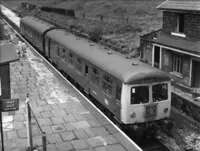
27th May 1972
Set: NH135
A Cravens DMU pulls into Ewood Bridge on 27 May 1972, one week before closure, on a Bury Bolton Street service with Alf Davenport in the driving seat. When the line between Bury and Rawtenstall was singled three signal boxes remained to control level crossings but the distant signals for these became fixed and Alf was not impressed. "If a man needs a fixed distant he shouldn't be on the railway" he would say. Fair point Alf - proud of his craft to the end, even on this very run down shadow of a former main line. DMBS M50782 is closest, the DMCL is thought to be M50815 labelled NH135. Image courtesy of Mark Bartlett. WA Camwell Collection.

3rd June 1972
Set: NH135
Set NH135 led by M50782 with M50815 at Rawtenstall is on the 12:05 Rawtenstall to Bury, on the last day of services on the Rossendale line before it closed - 3/6/1972. Robert Chilton.

January 1982
Class 105s & 101 Millerhill Jan 1982. Withdrawn Cravens unit 50782 (formerly a Midland Region allocation) plus an SC one, thought to be 50770, and a Met Cam centre trailer await towing south for scrapping. Alistair Ness.
50783
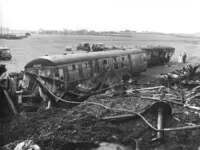
16th July 1961
One of a series of images credited to the LMR Mechanical & Electrical Engineers Department at Derby recording the aftermath of the collision on Singleton Bank (near Weeton) where a six-car DMU excursion struck the rear of a stationary ballast train on 16 July 1961. This is image 5, captioned "1st. & 2nd. diesel rail cars Nos. M.50808, M.50783 (after being moved from track)." M50783 is closest, both vehicles would be withdrawn. British Railways.
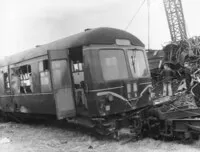
16th July 1961
One of a series of images credited to the LMR Mechanical & Electrical Engineers Department at Derby recording the aftermath of the collision on Singleton Bank (near Weeton) where a six-car DMU excursion struck the rear of a stationary ballast train on 16 July 1961. This is image 16, captioned "Trailing end 2nd. diesel rail car M.50783." British Railways.

16th July 1961
One of a series of images credited to the LMR Mechanical & Electrical Engineers Department at Derby recording the aftermath of the collision on Singleton Bank (near Weeton) where a six-car DMU excursion struck the rear of a stationary ballast train on 16 July 1961. This is image 19, captioned "Damaged rear vehicles of ballast train on left." The cab of 50783 can be seen in the field to the left, the roof of 50808 above it, and the cab end of 51780 can just be glimpsed to the right of the crane. British Railways.
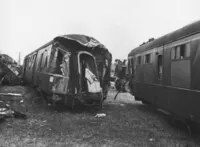
16th July 1961
One of a series of images credited to the LMR Mechanical & Electrical Engineers Department at Derby recording the aftermath of the collision on Singleton Bank (near Weeton) where a six-car DMU excursion struck the rear of a stationary ballast train on 16 July 1961. This is image 22, captioned "Leading end of 2nd. diesel rail car M.50783." On the right is M50808. British Railways.
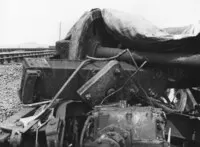
16th July 1961
One of a series of images credited to the LMR Mechanical & Electrical Engineers Department at Derby recording the aftermath of the collision on Singleton Bank (near Weeton) where a six-car DMU excursion struck the rear of a stationary ballast train on 16 July 1961. This is image 24, captioned "Top centre casting of second vehicle M.50783." British Railways.

16th July 1961
One of a series of images credited to the LMR Mechanical & Electrical Engineers Department at Derby recording the aftermath of the collision on Singleton Bank (near Weeton) where a six-car DMU excursion struck the rear of a stationary ballast train on 16 July 1961. This is image 26, captioned "Failure of top centre casting trailing bogie of second vehicle M.50783." British Railways.
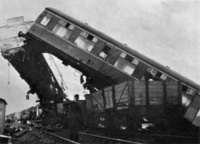
16th July 1961
Cravens DMBS M50783 (right) and DMCL M51780 (left) after colliding with a ballast train at Singleton Bank (near Weeton) on 16 July 1961 while working the 8.50am Colne to Fleetwood service. Image taken from the accident report. British Railways.
50784
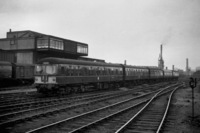
circa 1967
Manchester Victoria about 1967 with Cravens power-twin and 3 car BRCW unit arriving. The leading coach looks like M50784 which had AEC engine and standard gearbox. Good view of Victoria signal box as well. Edgehillsignallman@Flickr.

18th September 1979
With the former Lancashire & Yorkshire Railway station at Blackburn as a backdrop, Cravens 105 two-car DMU with DMBS M50784 leading, was in the West facing bay platform with a service to Manchester Victoria, via Bolton on September 18th 1979. These distinctive power-twin units were associated with the ex LYR routes in Lancashire for nearly thirty years. Blackburn Station was the last of the large L&Y stations to remain intact with its overall roof and iron & glass canopies, all since replaced by modern structures in the name of progress. Martyn Hilbert.
50785

July 1977
Two Class 105 power twins are seen at Bott Lane - between Nelson and Colne - in early July 1977. The leading DMCL appears to be M50785. Michael Mensing.

1st December 1979
Class 105 DMCL off its bogies and with a buffer and much of the underframe equipment removed at Newton Heath on 1 December 1979. The cab has signs of damage, it would be withdrawn in July 1980. Brian Daniels.
50786

1966
DMSL M50786 leads a three-car Cravens and a three-car Met-Camm with a Birmingham service seen near Arley (between Whiteacre and Nuneaton) in mid-1966. Michael Mensing.
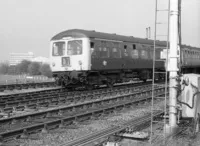
1976
Set: TS413
Tyseley set TS413 with Class 105 DMCL M50786 and a Class 101 DTCL, presumably M56411, in view at Stratford-upon-Avon in 1976. Stuart Mackay Collection.

13th August 1976
Set: TS413
A Tyseley scratch set (TS413) formed of a Class 105 DMCL (M50786), a Class 101 DTCL, and a Class 100 DMBS seen at Leicester on 13 August 1976. Nicholas T Smith.

30th May 1978
Set: TS413
Tyseley hybrid DMU set TS413 (Class 105 DMCL M50786, a Class 105 DTSL which looks like M56456 and a Class 101 DMBS) with a refurbished Class 116 on the rear is seen on a southbound ECS leaving Four Oaks on 30 May 1978. Michael Mensing.


